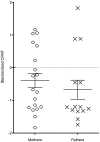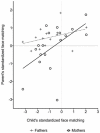Facial identity recognition in the broader autism phenotype
- PMID: 20877561
- PMCID: PMC2943915
- DOI: 10.1371/journal.pone.0012876
Facial identity recognition in the broader autism phenotype
Abstract
Background: The 'broader autism phenotype' (BAP) refers to the mild expression of autistic-like traits in the relatives of individuals with autism spectrum disorder (ASD). Establishing the presence of ASD traits provides insight into which traits are heritable in ASD. Here, the ability to recognise facial identity was tested in 33 parents of ASD children.
Methodology and results: In experiment 1, parents of ASD children completed the Cambridge Face Memory Test (CFMT), and a questionnaire assessing the presence of autistic personality traits. The parents, particularly the fathers, were impaired on the CFMT, but there were no associations between face recognition ability and autistic personality traits. In experiment 2, parents and probands completed equivalent versions of a simple test of face matching. On this task, the parents were not impaired relative to typically developing controls, however the proband group was impaired. Crucially, the mothers' face matching scores correlated with the probands', even when performance on an equivalent test of matching non-face stimuli was controlled for.
Conclusions and significance: Components of face recognition ability are impaired in some relatives of ASD individuals. Results suggest that face recognition skills are heritable in ASD, and genetic and environmental factors accounting for the pattern of heritability are discussed. In general, results demonstrate the importance of assessing the skill level in the proband when investigating particular characteristics of the BAP.
Conflict of interest statement
Figures



Similar articles
-
Heterogeneity of subclinical autistic traits among parents of children with autism spectrum disorder: Identifying the broader autism phenotype with a data-driven method.Autism Res. 2017 Feb;10(2):321-326. doi: 10.1002/aur.1661. Epub 2016 Jul 7. Autism Res. 2017. PMID: 27383033
-
Face individual identity recognition: a potential endophenotype in autism.Mol Autism. 2020 Oct 21;11(1):81. doi: 10.1186/s13229-020-00371-0. Mol Autism. 2020. PMID: 33081830 Free PMC article.
-
Visual scan paths and recognition of facial identity in autism spectrum disorder and typical development.PLoS One. 2012;7(5):e37681. doi: 10.1371/journal.pone.0037681. Epub 2012 May 29. PLoS One. 2012. PMID: 22666378 Free PMC article.
-
The Broad Autism (Endo)Phenotype: Neurostructural and Neurofunctional Correlates in Parents of Individuals with Autism Spectrum Disorders.Front Neurosci. 2016 Jul 22;10:346. doi: 10.3389/fnins.2016.00346. eCollection 2016. Front Neurosci. 2016. PMID: 27499732 Free PMC article. Review.
-
Investigating the Evidence of Behavioral, Cognitive, and Psychiatric Endophenotypes in Autism: A Systematic Review.Autism Res Treat. 2017;2017:6346912. doi: 10.1155/2017/6346912. Epub 2017 Jul 5. Autism Res Treat. 2017. PMID: 28761767 Free PMC article. Review.
Cited by
-
Investigating the Influence of Autism Spectrum Traits on Face Processing Mechanisms in Developmental Prosopagnosia.J Autism Dev Disord. 2023 Dec;53(12):4787-4808. doi: 10.1007/s10803-022-05705-w. Epub 2022 Sep 29. J Autism Dev Disord. 2023. PMID: 36173532 Free PMC article.
-
Developmental plateau in visual object processing from adolescence to adulthood in autism.Brain Cogn. 2014 Oct;90:124-34. doi: 10.1016/j.bandc.2014.06.004. Epub 2014 Jul 12. Brain Cogn. 2014. PMID: 25019999 Free PMC article.
-
Paternal-but Not Maternal-Autistic Traits Predict Frontal EEG Alpha Asymmetry in Infants with Later Symptoms of Autism.Brain Sci. 2019 Nov 26;9(12):342. doi: 10.3390/brainsci9120342. Brain Sci. 2019. PMID: 31779221 Free PMC article.
-
Initial eye gaze to faces and its functional consequence on face identification abilities in autism spectrum disorder.J Neurodev Disord. 2019 Dec 28;11(1):42. doi: 10.1186/s11689-019-9303-z. J Neurodev Disord. 2019. PMID: 31883518 Free PMC article.
-
Autistic traits below the clinical threshold: re-examining the broader autism phenotype in the 21st century.Neuropsychol Rev. 2011 Dec;21(4):360-89. doi: 10.1007/s11065-011-9183-9. Epub 2011 Oct 12. Neuropsychol Rev. 2011. PMID: 21989834 Review.
References
-
- American Psychiatric Association. Diagnostic and Statistical Manual of Mental Disorders (4th, text revision (DSM-IV-TR) ed.) 2000.
-
- Kanner L. Autistic disturbances of affective contact. Nervous Child. 1943;2:217–250. - PubMed
-
- Bolton P, Macdonald H, Pickles A, Rios P, Goode S, et al. A case - control family history study of autism. Journal of Child Psychology and Psychiatry and Allied Disciplines. 1994;35(5):877–900. - PubMed
-
- Folstein S, Rutter M. Genetic influences and infantile autism. Nature. 1977;265:726–728. - PubMed
-
- Piven J, Palmer P, Jacobi D, Childress D, Arndt S. Broader autism phenotype: Evidence from a family history study of multiple-incidence autism families. American Journal of Psychiatry. 1997;154(2):185–190. - PubMed
Publication types
MeSH terms
LinkOut - more resources
Full Text Sources

